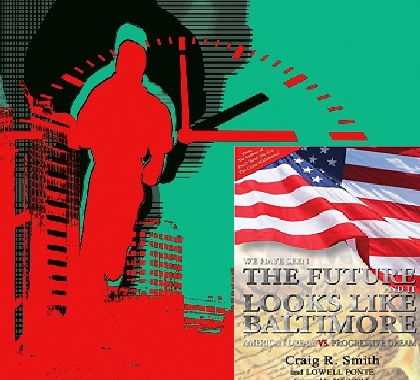We Have Seen the Future and It Looks Like Baltimore: American Dream vs. Progressive Dream, Craig R. Smith and Lowell Ponte (P2 Publishing, 2015), 252 pages, ISBN-13: 978-0996847605; $17.28 on Amazon.com
Over the past year, a feeling of frustration and despair seems to have taken hold of many people across the United States.
We Have Seen the Future and It Looks Like Baltimore, written by political commentators Craig Smith and Lowell Ponte, shows readers why people’s simmering frustrations with the political status quo are coming to a boil. They accomplish this by focusing on the causes of the April 2015 riots in Baltimore, Maryland, which were sparked by the death of Freddie Gray, an African-American, while under arrest by city police.
American Dream vs. Progressive Dream
Although the book’s title suggests a focus on Baltimore and Gray, the authors extrapolate the news to a wider theme, weaving a treatise explaining how liberalism’s “progressive dream” has supplanted the “American dream” the nation’s founders hoped to foster.
In the world of the progressive dream, Smith and Lowell write, individuality is subordinated to the best interests of the collective, which is, in practice, the government’s best interests. In Europe, the progressive dream yielded communism, Nazism, fascism, and the socialist welfare states now commonly found there.
Tracing the liberal fantasy’s roots in the United States, the authors highlight Woodrow Wilson as one of the fathers of the American liberal movement, whose standard is now borne by President Barack Obama.
Desire for ‘Total Control’
The authors’ exhortation to “remember who the progressives really are and the total control over the rest of us that they really want” is poignant given Obama’s efforts over the past eight years to take control of the American health care system and other sectors of the economy, especially energy.
Smith and Ponte remind readers America was founded by individuals seeking autonomy from autocrats controlling them from afar, evoking readers’ memories of the federal government’s many and various intrusions into the market over the years.
Smith and Ponte says government social-engineering programs are subtle and insidious and take many forms, such as monetary policies that artificially increase the cost of housing and real estate and student loan programs that promote ideologies and dependence on government by redistributing wealth from taxpayers to colleges and universities.
All of this progressive dream-making has resulted in massive taxpayer liabilities and the devaluation of the worth of a college degree, Smith and Ponte write.
Making Work Not Work
The authors explain why almost eight million Americans are unemployed and hundreds of thousands more chose to stop looking for work. In most states—35 out of 50—dependency on government entitlement programs pays more than work, making the decision to accept the dole an economically rational one for many people.
In Hawaii, for example, one can collect up to $60,590 a year in government entitlements, redistributing wealth from those who choose to work to those who choose not to. In Washington, DC, individuals can receive up to $50,820 a year in taxpayer-funded benefits. The lavish nature of government entitlement programs punishes work by making it a sucker’s game, Smith and Ponte write.
International Relevance
Although some parts of the book are more speculative than others, it remains an engaging and darkly honest examination of what’s going wrong with America. Zooming out a step further, We Have Seen the Future and It Looks Like Baltimore contrasts the American Dream with the reality being experienced by European countries attempting to realize the progressive dream, such as Denmark and Sweden.
The European Union (EU) experiment is a fundamentally untenable mishmash of competing interests, and the effects are being felt in every participating country—all the way from top to bottom, from Germany to Greece, write Smith and Ponte.
The European Union was intended to foster trade by creating a common currency, instituting broader use of the German deutschmark by calling it by another name. Having failed to conquer Europe through violence, the authors suggest, Germany used economics to achieve that goal, through monetary policy.
The authors say this plan was flawed from the start. Lawmakers in countries with weaker economies, such as Greece and Portugal, used loans made through the European Union’s central bank as though they were limitless credit cards, spending to their hearts’ content without consideration of later repayment.
Smith and Ponte say German taxpayers have already paid the price for their neighbors’ liberal irresponsibility, to the tune of hundreds of billions of dollars, and they are under pressure to issue more blank checks. The European Union is unstable because it is a multi-decade experiment attempting to emulate the United States by establishing a common currency without much in the way of a common government, write Smith and Ponte.
Gloomy Prospects
If one sets out to uncover and examine how lawmakers’ ideological inequities and mismanagement have led to the problems of today, one would be hard-pressed to produce a better book than We Have Seen the Future and It Looks Like Baltimore.
At times, this book may paint a gloomy vision of the future we face, but such bitter medicine should not be avoided. Before one can set out to solve problems of this magnitude, one must know the challenges facing the American dream. We Have Seen the Future and It Looks Like Baltimore is a potent primer for those brave enough to challenge the progressive reality of decline and decay.





